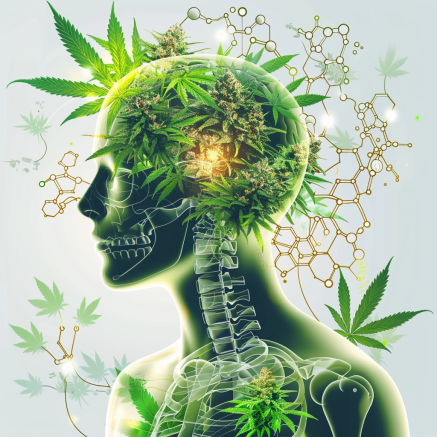Ever pondered about what exactly are cannabis terpenes and why they exhibit varied scents and effects?
The secret lies in the minute yet potent molecules responsible for the unique aroma and specific effects of cannabis.
These tiny marvels of nature influence not just our olfactory experience, but also how we perceive the impact of cannabis.
In this article, we dive deep into the realm of terpenes, explore their diversity, and discover how they shape our cannabis experience. Prepare to meet the invisible champions of your high and unveil their significance for your cannabis journey.
A Quick Recap for the Lazy Reader
Terpenes in cannabis do more than just carry the aroma. They modulate your high and enhance the therapeutic properties of cannabis by synergizing with cannabinoids. Through interactions with THC and CBD, they contribute to a personalized and nuanced cannabis experience, supported by the entourage effect.
Decoding Terpenes
Terpenes are those magical molecules that give nature its scent and taste.
From the lavender blossom in your garden to the lemon peel in your kitchen – terpenes are omnipresent. However, in the kingdom of cannabis, they play a very special role.
They are the aroma architects that give each strain its characteristic fragrance. But terpenes do more than just olfactory aesthetics – they also influence how different strains of cannabis impact us and make us feel.
The Chemical Aspect
Chemically speaking, terpenes are hydrocarbon compounds produced in the trichomes of the cannabis plant – those shiny, sticky glands that coat the flowers and leaves.
Their primary job is to protect plants from predators and diseases while attracting pollinating insects. To us humans, they mean much more: they define the “aroma profile” of our favorite weed strains.

The Interaction with Our Body
When inhaling, smoking, or vaping cannabis, terpenes interact with our bodies in a way that can influence the overall experience.
They work hand in hand with cannabinoids like THC and CBD to enhance what is often described as the “entourage effect” – a synergistic relationship potentially augmenting the therapeutic properties of cannabis, which we will elaborate on later in this article.
So next time you take a deep drag from your vape or sniff at your freshly ground buds, remember that you’re experiencing a whole concert of terpenes working together to provide exactly the experience you’re seeking.
What Types of Cannabis Terpenes are There?
In the kaleidoscope of cannabis aromas, terpenes play the lead role, determining whether a strain smells more like fresh lemons or deep, earthy forest. Here’s a look at some of the most prominent terpenes you can find in cannabis and the nuances they bring:
- Myrcene Aroma: Earthy, musky with a hint of ripe fruits. Effect: Myrcene is the most common terpene in cannabis and contributes to the relaxing properties of many strains.
- Limonene Aroma: Fresh and citrusy, reminiscent of lemons and oranges. Effect: Limonene is known for its mood-lifting effects and can also enhance the absorption of other terpenes.
- Linalool Aroma: Sweet, floral with a touch of lavender. Effect: Linalool has a calming effect and is often found in anxiety-reducing and relaxing cannabis strains.
- Pinene Aroma: Clear, fresh, with a strong pine scent. Effect: Pinenes are known for their anti-inflammatory properties and can help sharpen memory.
- Caryophyllene Aroma: Spicy, peppery, with a woody undertone. Effect: Caryophyllene interacts directly with the endocannabinoid system and offers potential therapeutic benefits.
These terpenes and many more form the complex mosaic of cannabis aromas. Each has its own character and contributes uniquely to the overall experience. Knowing these terpenes can help you make more targeted cannabis choices and craft the desired experience.
Do Terpenes Impact the Effects of Cannabis?
Synergistic Interplay with Cannabinoids: Terpenes interact with cannabinoids in a process known as the “entourage effect.”
This means that terpenes have the ability to amplify or diminish the effects of THC and CBD. For instance, Myrcene can make the blood-brain barrier more permeable to THC, thereby enhancing its psychoactive influence. Other terpenes, like Limonene, can have mood-boosting effects, thereby enhancing overall well-being.

Enhancing Therapeutic Potential: The interaction of terpenes with cannabinoids doesn’t just contribute to a diverse psychoactive experience, but may also boost the therapeutic potential of cannabis.
Terpenes like Linalool and Caryophyllene offer their own therapeutic benefits such as easing anxiety and reducing inflammation. Their combination with cannabinoids can lead to synergistic effects that may prove useful in treating various ailments and conditions.
Personalizing Cannabis Experiences: Understanding how cannabis terpenes influence its effects allows consumers to personalize their experiences.
By choosing strains with specific terpene profiles, one can more precisely target desired effects – be it relaxation, pain relief or mood elevation.
The science behind how terpenes impact cannabis is fascinating and leaves much room for discovery. What’s clear is their indispensable role in shaping the cannabis experience, both in terms of aroma and effect.
The Entourage Effect – A Matter of Perception or Objective Reality?
The entourage effect is based on the theory that cannabinoids like THC and CBD, when combined with cannabis terpenes, produce a more complex, potentially more effective impact than when consumed in isolation.
Studies suggest that terpenes can influence the affinity of cannabinoids for their receptors, amplifying the therapeutic properties of cannabis.
This synergy might explain why full-spectrum cannabis products are often perceived as more effective than isolated cannabinoids. Though the concept of the entourage effect is intriguing, research is still in its early stages.
While some studies hint at a synergistic effect, comprehensive clinical investigations that substantiate this theory are lacking. Critics argue that the effects of cannabis are so individual that it’s difficult to draw definitive conclusions about the universal validity of the entourage effect.

Many cannabis consumers report varied effects depending on the strain consumed and its specific terpene and cannabinoid profile. These personal experiences support the idea of the entourage effect, though they’re scientifically challenging to quantify.
For many, subjective experience is paramount, and the entourage effect provides a plausible explanation for nuanced differences in the cannabis experience.
Though the entourage effect continues to be a subject of scientific debate, it underscores the complexity of cannabis and the importance of a holistic view of its active ingredients. As research progresses, individual experience remains a central aspect of cannabis consumption, enriched by the unique interplay of terpenes and cannabinoids.
Conclusion – The Role of Terpenes in Cannabis Consumption
Terpenes in cannabis are real all-rounders. They not only give each strain its unique aroma and flavor profile but also significantly influence the impact of cannabis.
From the calming lavender scent of Linalool to the refreshing citrus aroma of Limonene – terpenes enrich our sensory experience and contribute to a nuanced high through the entourage effect.
Their potential goes beyond what we’ve explored so far, particularly in terms of therapeutic applications. Our final advice: When purchasing cannabis next time, pay attention not only to THC and CBD content but also consider the terpene profile. It could elevate your experience to a whole new level.
This isn’t just theory but established knowledge within the scene. No wonder there are so-called “Terp Hunters” – consumers on the lookout for the most extraordinary and best cannabis terpenes.
Cannabis terpenes are aromatic compounds produced in the trichomes of the cannabis plant, responsible for its unique scents and flavors, and influence its effects on the body.
Terpenes work alongside cannabinoids to enhance or modify the effects of cannabis, contributing to what is known as the “entourage effect.”
Yes, terpenes can enhance the therapeutic effects of cannabis by interacting synergistically with cannabinoids, potentially offering benefits like anxiety relief and inflammation reduction.
The entourage effect refers to the synergistic interaction between cannabinoids and terpenes in cannabis, believed to enhance the overall effects and therapeutic potential.
While generally safe, high concentrations of certain terpenes can be irritating to some individuals, especially when inhaled or in contact with skin.









